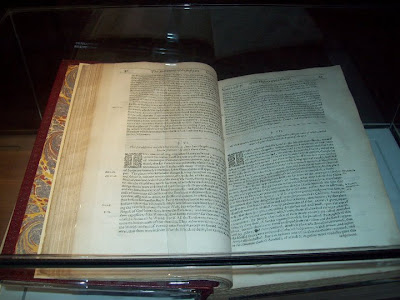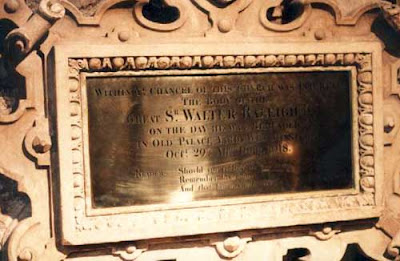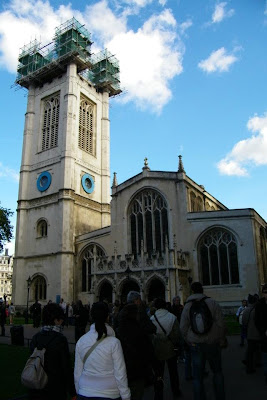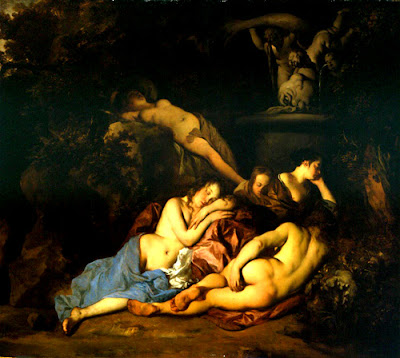Sir Walter Raleigh by an unknown artist
On this day in history, 1618; sir Walter Raleigh was beheaded upon the orders of James I. But why was this man, once a great favourite of Elizabeth I, given such a death and executed as a traitor? With this post, I will give a brief overview of his life up until the reign of James I; and then will discuss in more detail the events that lead up to his trial and execution in 1618.
Sir Walter Raleigh was born in 1554 to Walter Raleigh and Catherine Champernowne in Hayes, Devon. Little Walter's family had links to royalty back to the thirteenth century, and his father had previously been Lord Vice Admiral to Mary I from 1555-58. We know from Raleigh's later work that he was an incredibly intelligent man, but really very little is known about his childhood years and what sparked that brilliant mind. What we do know though is that from 1569 (from the age of 15 or so) he served as a volunteer in France during their religious wars. He returned to England in 1570. We also know that he spent some years at Oriel College in Oxford, although the exact date that he entered the college has not been recorded. He left Oxford without his degree, which at the time was not unusual and went to the Middle Temple (sort of like a law school) in the February of 1575. Whilst there he began penning poetry, the first of which was published in 1576. Raleigh was in fact related to Katherine Ashley, first gentlewoman of Elizabeth I's bedchamber, through his mother and it is possible that this link allowed him to meet other great courtiers such as Robert Dudley. In 1578, he teamed up with a man by the name of Humphrey Gilbert and set sail on an adventure to discover remote lands. He returned the following year.
In 1581, following a brief stint as a soldier in Ireland, Raleigh began to attract the attentions of Elizabeth I and spent a good few years as her favourite. That was until he earned her displeasure by entering into a liaison with one of her maids; Elizabeth Throckmorton. Having gotten Elizabeth pregnant, the two married in secret. Raleigh knew how displeased the Queen would be and so made plans to set sail once more, yet when he returned from his voyage in 1592, the Queen was well aware of what had happened. She had the couple separated and both were sent to the Tower of London. It took a while for Elizabeth to even think of forgiving the couple and both were eventually released from the Tower. Their first son disappears from the record, but in 1593 Elizabeth gave birth to another little boy. However, they were both still banished from court and it took Raleigh a while to return to favour. Raleigh was not allowed back to court until 1597 and during those years of disgrace had spent a good many years on his travels searching for the fabled El Dorado and explored the areas of Guyana and Eastern Venezuela. He had managed to get his hands on a description of a City of Gold, yet despite his years of searching never found it.
When Elizabeth I died in 1603, Raleigh had not long been back in favour yet had spent a good few years still adventuring and also dabbling in poetry. When news broke of Elizabeth's death, he hastened to meet the new King James, yet did not exactly receive a warm welcome. Despite being present at the Queens funeral as an official attendant, following this he was rebuffed quite harshly by the new ruler - James I (also James VI of Scotland) stripped him of his monopolies as well as his captaincy of the Guard and was told that he had to leave his current place of residency, Durham Place. In July of 1603 Raleigh was also questioned on two counts of treason and placed under house arrest. Yet what were these treason's? It had come to James' ear that Raleigh had been involved in a number of plots, including planning rebellion and a Spanish invasion, as well as plotting the death of the King. It is said that he planned to place Lady Arabella Stuart in James' place as monarch.
Arabella Stuart by Lowres
Raleigh was taken to the Tower on 20th July 1603. There he wrote a farewell letter to his wife, and on 27th July tried to take his own life by stabbing himself in the heart with a table knife. The attempt failed, and after a while he realised that the only evidence of any substance held against him was a statement made by a man who thought Raleigh had betrayed him. It seems that the gentleman who made the accusations withdrew them almost immediately although Raleigh did not know this until he was brought to trial on 17th November. At any rate, Raleigh was found guilty - despite the fact that Cobham had withdrawn his accusations, he was still found guilty of a more sweeping treason thanks to various letters from Cobham making out that Raleigh had passed on information on the King's military endeavours and trying to get money out of others for military intelligence. Raleigh was taken back to the Tower, and there held until 1612. After his trial, he despaired of mercy from King James and wrote another letter to his wife. However in December 1503, King James agreed that Raleigh could keep his life.
During his years in the Tower, Raleigh dabbled in chemistry. There he created various medicines, but when he fell sick in 1615 it was put down to his dabbling in chemicals. Whilst locked away he also wrote his famous History of the World. There is a copy of this still on show in the Tower of London. He began the work in around 1607, and it was intended to be widely published as the first part of his history of the world. The entire work works out as around 5 volumes, and the first two volumes make up the biblical history of how the world came into being and the final three volumes deal with the histories of the Greek and Roman Empires.
Walter Raleigh's History of the World. Photo by me
Reconstruction of Raleigh's rooms in the Tower. Photo by me
when he returned to England, the Spanish ambassador had already been to King James with reports of the violence that had happened at San Thome. The ambassador demanded Raleigh's arrest and not long after he landed, he was arrested and taken to London. On 10th August 1618, Raleigh found himself back in the Tower. This time, there would be no escape for Sir Walter Raleigh.
On 22nd October, Raleigh was brought before the Privy Council. There he was accused of being ungrateful to the King who had forgiven him his previous treason's, accused of planning to start a war between England and Spain, and moreover was accused of deserting his men. On 28th October, a verdict was passed. Sir Walter Raleigh was guilty. Yet Raleigh threw himself on the Kings mercy, pleading for clemency. It didn't work, and Raleigh was sentenced to execution. He spent his last night in the Gatehouse at Westminster and on the morning of 29th October 1618 was beheaded at Westminster. His execution speech was long and he welcomed the fact that he was going to die. His final speech lasted for almost forty five minutes and in it he insisted that his expeditions had no ulterior motive, that he had never sought to plot with France and start a war between England and Spain.
Just before he knelt he spoke a few more words, admitting that he had been a man of vanity and joked with the executioner that the axe would be his "sharp medicine". And once the fatal blow was struck, his head was placed in a red bag and taken away by his wife who kept it until her own death. It is said that she liked to bring out his head when she had visitors. Once she died, his head was returned to the rest of his remains at St Margaret's Church next to Westminster Abbey.
Raleigh's memorial plaque inside St Margaret's Church
St Margaret's Church, Westminster. Photo by me.
Mark Nicholls, Penry Williams, ‘Ralegh, Sir Walter (1554–1618)’, Oxford Dictionary of National Biography, Oxford University Press, 2004; online edn, Jan 2008 [http://www.oxforddnb.com/view/article/23039, accessed 29 Oct 2012]
Sir Walter Raleigh: In Life & Legend - Penry Williams & Mark Nicholls
The Favourite - Mathew Lyons











.jpg)






















.jpg)
.jpg)